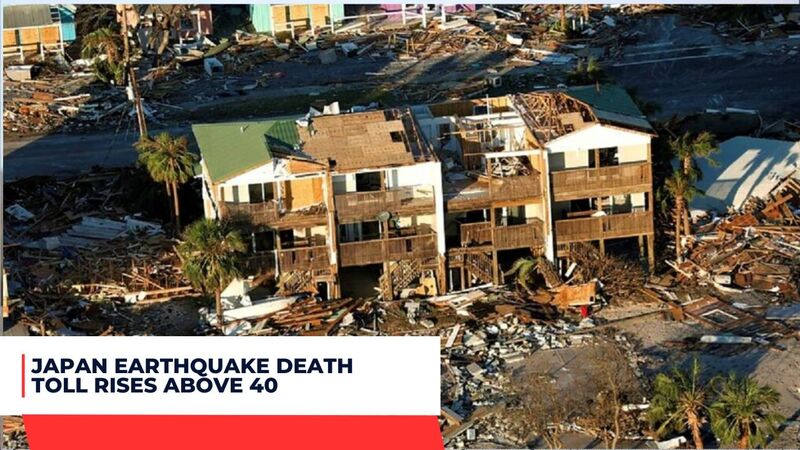On New Year’s Day, Japan was rocked by a strong earthquake which devastated homes and cut roads off, as well as suspending rail services, ferries, and flights into and out of the region.
Fumio Kishida, Japan’s Prime Minister, warned rescuers were fighting a race against time to reach those trapped inside damaged buildings and asked residents in affected areas to seek safety as quickly as possible and evacuate should necessary.
The quake
On New Year’s Day, a powerful 7.6-magnitude earthquake rocked western Japan, sparking fires and trapping people beneath collapsed buildings. Rescue operations were underway Tuesday morning local time; over 100,000 were left without electricity as of Wednesday afternoon local time.
At 4:10pm local time on Monday afternoon in Ishikawa Prefecture, an earthquake hit Noto Peninsula with seismic shockwaves of magnitude 4.10. Tsunami warnings were immediately issued but later cancelled after waves up to 10 feet were seen by NHK reporters.
NHK reported that 25 buildings, including houses, had collapsed in Wajima city alone. There have also been reports of fires; however due to damaged roads it may be difficult to access many affected areas.
Prime Minister Fumio Kishida revealed that members of the Self-Defense Force had joined police and firefighters in rescue operations to save those trapped inside collapsed buildings, calling for additional disaster relief funding and evacuation assistance from authorities. A disaster ministry official reported a large number of people had been forced out from their homes and had taken shelter outside overnight as shelter was unavailable to them.
The epicentre
On New Year’s Day, an earthquake and subsequent tsunami rocked north-central Japan, destroying buildings, toppling roads, triggering fires and leaving behind debris from buildings damaged or destroyed by the earthquake itself. It struck near Noto Peninsula protrusion into the Sea of Japan and caused waves at least four feet high in Wajima port city – prompting evacuation orders in place there.
Multiple cities experienced severe damage, with people trapped inside collapsed buildings or missing. NHK footage revealed a seven-story building toppling sideways before smoke billowed out from Wajima city center known for its morning market.
Fumio Kishida, Japan’s prime minister, issued an evacuation call for residents in affected areas as soon as possible to higher ground, with basic necessities to follow via water routes. Kishida ordered Self-Defense Force troops to reach hard-hit areas quickly due to debris on roads and buildings that have fallen down; access is difficult due to this debris and buildings that have collapsed; however the disaster agency warned of additional aftershocks likely in coming days.

The damage
According to reports, thousands of homes were destroyed by the earthquake. News footage showed collapsed buildings, wooden structures being levelled down, overturned cars and half-sunken ships floating about in bays.
Authorities warned of possible aftershocks and have tried to assess damage in Ishikawa Prefecture where the epicentre lies as well as locate people trapped under collapsed buildings. Many were left without transportation following Tuesday’s earthquake, leaving many people isolated far from major roads and roadways. Officials in that prefecture have also attempted to assess damage as they try to identify those trapped inside collapsed structures and assess any injuries sustained from collapsed structures.
The earthquake has also resulted in fires in Wajima, Suzu and Nanao cities and has been reported as responsible for missing persons from those regions. Fire department officials reported receiving numerous calls from individuals who are trapped inside due to structural problems within their homes and are therefore unable to evacuate – reports public broadcaster NHK.
The earthquake and its aftershocks prompted tsunami warnings which were later downgraded, but waves up to one meter high were observed in several spots. The warnings caused thousands of people to evacuate coastal areas.
The rescue
Japanese citizens are well trained on how to respond in an earthquake, with many newly built homes equipped with some degree of earthquake-resistance features. Unfortunately, a number of buildings in Wajima have collapsed leaving residents trapped inside them.
Local fire services reported receiving 50 calls from residents claiming their houses had collapsed, according to national broadcaster NHK. Furthermore, one airport had to close due to cracks appearing in its runway, access roads, terminal building and more than 140 tremors since Monday’s initial quake, prompting authorities to issue tsunami warnings.
Prime Minister Fumio Kishida warned of search and rescue efforts being a race against time, especially for anyone trapped under collapsed buildings. He advised those in the region to remain out of their homes until search and rescue operations have completed their work. US President Joe Biden sent his condolences and assistance from America as soon as a plan has been developed to assist victims.






